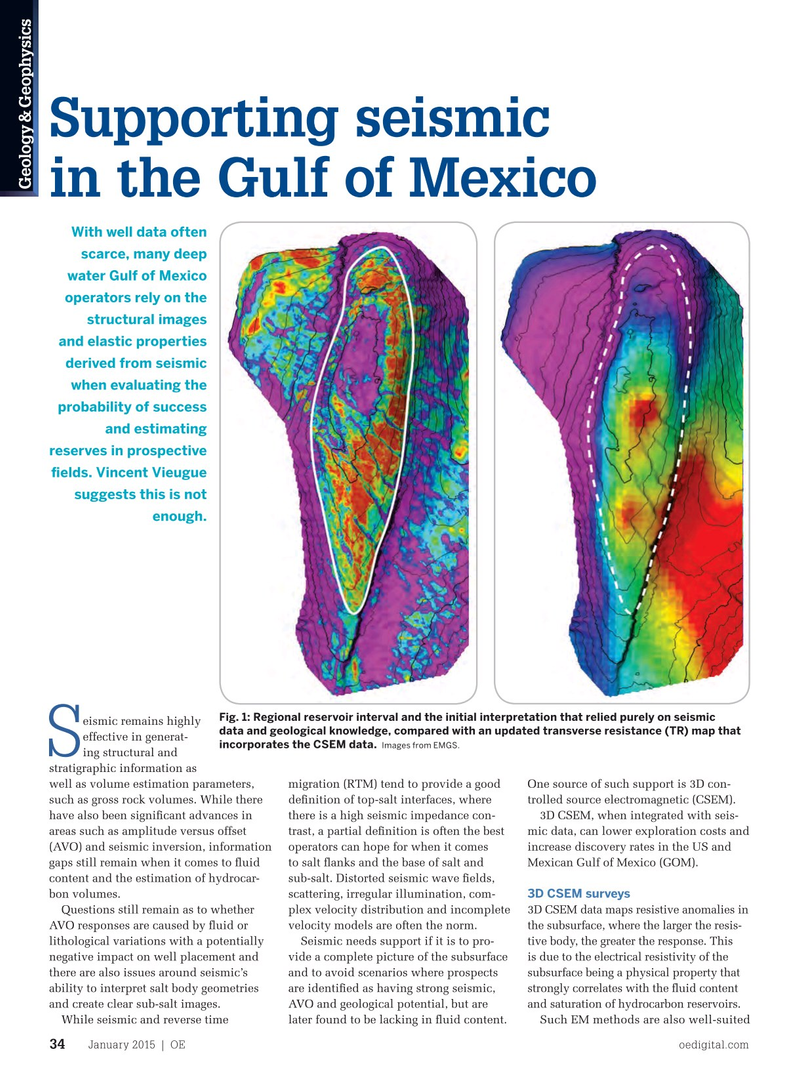
Page 32: of Offshore Engineer Magazine (Jan/Feb 2015)
Read this page in Pdf, Flash or Html5 edition of Jan/Feb 2015 Offshore Engineer Magazine
for imaging sub-salt sediment struc- tures, where an intelligent well-con- strained attribute correlation between inverted resistivity and compressional velocity in sediments can be used to
Supporting seismic refne the seismic velocity model and produce better seismic imaging for base- ment structures.
Geology & Geophysics
In addition, EM measures different in the Gulf of Mexico rock properties to seismic and is sub- sequently unperturbed by the scatter
With well data often and refraction that causes seismic such diffculties, accurately picking out the scarce, many deep base of the salt in depth by the change of water Gulf of Mexico resistance and then applying this to the velocity model.
operators rely on the
Whether in sub-salt felds or felds structural images with other geological characteristics, and elastic properties integrating EM data into the exploration workfow to support seismic allows for a derived from seismic better classifcation of prospects through when evaluating the the downgrading or upgrading of the probability of fnding hydrocarbons and probability of success an improvement in the evaluation of the and estimating size of the accumulation.
reserves in prospective 3D CSEM in the Gulf of Mexico felds. Vincent Vieugue
EMGS has a long history of conducting suggests this is not
CSEM surveys in the GOM.
Since 2010, EMGS has acquired over enough. 16,000sq km of 3D CSEM in the Mexican
Fig. 1: Regional reservoir interval and the initial interpretation that relied purely on seismic eismic remains highly data and geological knowledge, compared with an updated transverse resistance (TR) map that effective in generat- incorporates the CSEM data. Images from EMGS.
S ing structural and stratigraphic information as well as volume estimation parameters, migration (RTM) tend to provide a good One source of such support is 3D con- such as gross rock volumes. While there defnition of top-salt interfaces, where trolled source electromagnetic (CSEM). have also been signifcant advances in there is a high seismic impedance con- 3D CSEM, when integrated with seis- areas such as amplitude versus offset trast, a partial defnition is often the best mic data, can lower exploration costs and (AVO) and seismic inversion, information operators can hope for when it comes increase discovery rates in the US and gaps still remain when it comes to fuid to salt fanks and the base of salt and Mexican Gulf of Mexico (GOM). content and the estimation of hydrocar- sub-salt. Distorted seismic wave felds, 3D CSEM surveys bon volumes. scattering, irregular illumination, com- 3D CSEM data maps resistive anomalies in
Questions still remain as to whether plex velocity distribution and incomplete the subsurface, where the larger the resis-
AVO responses are caused by fuid or velocity models are often the norm.
tive body, the greater the response. This lithological variations with a potentially Seismic needs support if it is to pro- is due to the electrical resistivity of the negative impact on well placement and vide a complete picture of the subsurface subsurface being a physical property that there are also issues around seismic’s and to avoid scenarios where prospects strongly correlates with the fuid content ability to interpret salt body geometries are identifed as having strong seismic, and saturation of hydrocarbon reservoirs.
and create clear sub-salt images. AVO and geological potential, but are
Fig. 2: L – Seismic interpretation. R – Seismic and EM.
Such EM methods are also well-suited
While seismic and reverse time later found to be lacking in fuid content.
January 2015 | OE oedigital.com 34 034_OE0115_G&G1_EMGS.indd 34 12/22/14 8:23 PM

 31
31

 33
33